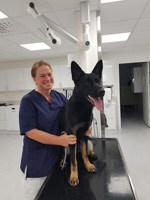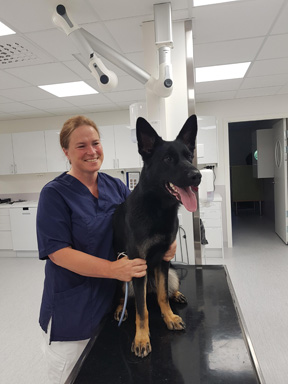
Maria Karlsson 288

Photo courtesy of Mittnorrlands Djursjukvård
Dr. Maria Karlsson, a specialist in dog and cat diseases, says widespread use of pet insurance in Sweden supports high clinical standards, including the use of high-quality medical equipment.
Just about every person and their dog has health insurance in Sweden, propelling the Nordic country to a near-mythic status in the veterinary domain.
High insurance-market-penetration rates, including a startling 90% for dogs, have deepened the funding pool available for care across the country's entire veterinary sector.
Clinical standards are high, working conditions for veterinarians are good and pay is at least comparable to that in other European countries, Swedish practitioners told the VIN News Service.
"It makes all the difference," Dr. Maria Karlsson, a specialist in dog and cat diseases at Mittnorrlands Djursjukvård, which has five clinics in the Östersund-Sunsvall area, said via telephone. "The high equipment quality that we have in our clinics — the CT scans, the MRIs and the really advanced orthopedic equipment — it's there because we have high levels of insurance of our pets."
Karlsson, who also serves as Mittnorrlands Djursjukvård's operational and quality control manager, said she and her colleagues sometimes work night shifts, but generally have their schedules capped at 40 hours per week. "We don't work around the clock, and we have decent pay for what we do," she said.
Dr. Bert-Jan Reezigt similarly is appreciative. A Dutch national, he works as a specialist in small animal diseases at the Blå Stjärnans Small Animal Referral Hospital in Gothenburg.
"Sometimes I wonder how different things would be if I still worked in Holland," he said via telephone. "The insurance money here in Sweden opens up a lot of possibilities for using more sophisticated treatments and diagnostics."
As much as pet insurance already is popular in the country, veterinarians and insurers say there is room for continued growth, as the escalating cost of veterinary care — driven in part by the availability of insurance — makes being uninsured a bigger financial risk.
Sweden's largest pet insurance company, Agria, is expanding its geographic reach, as well, armed with more than a century of experience in covering animals in its back yard.
Sweden's experience is of particular interest in markets such as that of the United States, where fewer than 2% of dogs and 0.5% of cats were insured in 2017. Many veterinarians wonder: How did their market develop? How are Swedish veterinarians affected by the widespread use of pet insurance? What is the effect on patient care? And might Sweden's high rates of pet-insurance use be replicated elsewhere in the world?
Horses, hamsters and everything in between
Agria, Sweden's oldest and largest pet insurance company, estimates that 90% of dogs in Sweden are covered. The rate is roughly 60% for horses and 50% for cats, according to Mikael Theorén, the company's area manager for horses and agriculture.
The only country to come remotely close to matching those proportions is the United Kingdom, where the market penetration rate is about 25% for companion animals.
Sweden's status as the world's top user of pet insurance is not driven by any specific legislation. All human residents there have health care costs covered by the government but there is no state support for pets in Sweden nor any rules that they be insured privately. Voluntarily, hundreds of thousands of households spend the equivalent of hundreds of U.S. dollars a year on private coverage for their pets.
There, as in most countries, the precise cost of insurance varies by a pet's breed and age, and the level of insurance that customers are willing to buy. For a Labrador retriever, a common and relatively healthy breed in Sweden, insurance costs about 4,400 Swedish krona ($455) per year, according to Agria's Theorén. Prices for a brachycephalic breed such as the English bulldog — whose characteristic short muzzle length and wrinkles are associated with respiratory and skin conditions, among other health issues — are nearly double, at 7740 Swedish krona ($800) a year, he said.
Those numbers do not differ much from in the U.S., where the average annual cost of pet insurance is $536 for dogs in general, and lower for Labradors, at $449, according to the financial data website ValuePenguin.
The price of insurance in Sweden is rising due, in part, to advances in medical technology that make care more expensive, along with pet-owner desires for high-level and consistent care, according to Theorén.
"We have seen increases in costs for treatments for at least the last five years ... though it looks like it has stabilized now," he told VIN News by telephone. "The price increases are really related to demands on the owner's side: They want 24/7 care and they want the latest treatment methods. They also want to have security — they want to be covered financially if something happens to their animal."
So despite the rising cost of pet insurance, demand in Sweden is not declining but rising, Theorén said.
He also notices a new trend of other types of pets, such as rabbits, guinea pigs and hamsters, being insured by their owners. The price to cover these little animals is about 500 Swedish krona (US$51) a year, about the same cost of buying a replacement rabbit and twice the cost of buying a new hamster, indicating a strong human-animal bond, he added.
A nation of rule takers, not rule breakers
Swedes' proclivity for insurance coverage is attributable partly to cultural idiosyncrasies, including the country's political climate.
"Sweden has socialist traditions, and some say you are taken care of from the cradle to the grave," said Reezigt. "In some ways, thoughts about controlling risk are more developed in Sweden."
Bert-Jan Reezigt 288

Photo courtesy of Dr. Bert-Jan Reezigt
Dr. Bert-Jan Reezigt, a practitioner in Sweden who has worked Holland as well as the United States, believes culture and political climate influence a country's use of pet insurance.
Reezigt is well-placed to compare Sweden with other countries due to his previous experience working as a veterinarian in his home country of Holland. He also has practiced in the U.S.
"In Holland, people tend to bike without a helmet, but in Sweden, it's like one of the 10 commandments that you wear a helmet when you bike," he said. "In Holland, they go against rules. Here in Sweden, they go with rules."
A theory that greater levels of state-backed health care provided to humans will inspire greater risk-aversion and therefore, higher pet-insurance penetration rates, seems supported by the situations in the U.K. and U.S. In Britain, where penetration rates also are relatively high, human health-care costs are met, to a large extent, by the state-funded National Health Service. By contrast, U.S. residents commonly pay for health insurance privately.
The complexity in the U.S. of dealing with the health insurance system for human patients, and the insurance's industry power in setting prices of medical services, causes many American veterinary practitioners to worry that widespread insurance for pets would be similarly cumbersome and controlling.
To date, no pet insurers in the U.S. attempt to negotiate prices with veterinary providers, but in the U.K., the insurer RSA in 2016 introduced a preferred referral network system as a means of controlling costs.
Reezigt said that while practicing in the U.S., he was fascinated by the high standard of care, even though most pets are uninsured. In his experience, clients had no problem pulling out their wallets to save their animals, regardless of price.
"Perhaps in some way, the animal side is mirrored by the human side," he said. "In Sweden, health care is really well taken care of by the state, but in the United States, there’s more emphasis on private coverage."
Mittnorrlands Djursjukvård’s Karlsson agrees that Swedes are a more cautious people. "We insure everything here, from our kids to our laptops," she said. "It's basically part of our culture."
She points out that the popularity of pet insurance in Sweden also can be attributed in part to enduring, well-established business practices. Agria, for instance, long has had a close marketing relationship with Swedish kennel clubs, which often recommend that buyers take out its insurance policies for puppies.
Swedish insurer eyes global expansion
Sweden's long history in pet insurance has given the concept of covering animals more time to gestate in the national psyche. Pet insurance is thought to have originated globally in 1924, when Agria wrote its first insurance policy for a Swedish dog. The company's insurance activities started with horses and farm animals when it was founded in 1890. Agria still sells insurance to farmers for livestock and crops.
Agria's Theorén said Sweden has a particularly strong respect for animal welfare that traces back to a need for animals to assist with agricultural work. "Animals have long been treated as more or less family members in Sweden," he said.
Today, Sweden has some of the strictest animal protection regulations in the world. The country's Animal Welfare Act, for example, requires that livestock be sedated before slaughter. For domestic pets, rules introduced in 2008 mandated that dogs kept indoors must be within view of a sunny window.
Other insurance companies have cropped up over the years to compete with Agria. Agria still dominates, with a 55% market share, followed by Folksam with 21%, then IF Skadeförsäkring and Sveland, with 9% each, according to a report released last year by the Swedish Competition Authority.
Dr. Stephan Haverkamp, managing director of Munich-based pet insurance company TIERdirekt, said many insurers in countries with low penetration rates have underestimated the cost of acquiring customers and paying claims. That's prompted some to incorporate more exclusions in their policies, leading to a lot of dissatisfied customers. "It is a vicious circle, and that's what we see in many countries," he said in a telephone interview.
By contrast, companies in Sweden and the U.K. offer more sophisticated products, often with broader coverage, he said. Adjusting pricing based on breed, age, gender, weight and location has enabled them to offer more attractive premium rates for younger, healthier animals and build up their coverage reserves.
Haverkamp said Swedish insurers have done a particularly good job educating customers about the benefits of pet insurance, and enrolling pets while the animals are young.
Insurers in Sweden are allowed to refuse coverage for older animals, meaning most customers are locked into a policy for their pet’s lifetime. Typical exclusions from insurance policies include umbilical hernia, hooked tail, mood disorders and dental conditions caused by bad hygiene, according to the Swedish Competition Authority report. On a breed-specific basis, English or French bulldogs, Boston terriers and pugs typically are not covered for conditions affecting the trachea, soft palate, nostrils or constrictions in the throat.
Despite the cultural and historical differences between the Swedish market and those outside the country, Theorén is optimistic that the penetration rates seen in Sweden can spread to other parts of the world.
"I think so," he said. "For Agria, at least, we are looking internationally." The company has established itself in five other countries: Denmark, Norway, Finland, the U.K. and most recently, France, where it opened its first office in 2018.
Haverkamp, too, is optimistic that higher penetration rates can spread elsewhere, as the rising cost of veterinary care makes insurance more attractive. He set up TIERdirekt last year with reinsurance giant Munich Re to take on the German pet insurance market, where only 1.5% of pets are covered.
Relatively low veterinary fees and high insurance taxes have presented challenges in Germany, he noted. Haverkamp added that escalating treatment costs are prompting pet owners increasingly to demand unrealistically low prices. "That is becoming a more frequent dilemma for the veterinarians," he said.
Pet-insurance operations at Folksam, Sweden's No. 2 pet insurer, are limited to the Swedish market. The company's marketing manager for animal insurance, Jan Lindblom, said it is not interested in expanding abroad in the "foreseeable future."
IF Skadeförsäkring confirmed that it has operations in Norway, Denmark and Finland, but declined to comment on whether it is eyeing other countries for expansion. Sveland declined to comment for this article.
The downside to widespread pet coverage
High insurance penetration rates might improve clinical standards and support a healthier work-life balance for veterinarians. But they also can drive up the costs of care, fueling higher premium rates and leaving those without pet insurance vulnerable to hefty veterinary bills.
What's more, high levels of pet insurance in Sweden do not appear to have improved the pay of veterinarians as compared with their colleagues in other countries, at least not substantially.
According to the Swedish Veterinary Association, median pay for veterinarians can range from a maximum 402,000 krona (US$41,225) for a starting position, up to 648,000 krona (US$70,143) after 10 years of experience, and up to 720,000 krona (US$73,831) after 20 years.
Veterinarians in the U.K earn a broadly comparable average of up to £50,000 (US$62,000) per year, government figures show. Veterinarians there, however, have told VIN News of tough working conditions.
In the U.S., veterinarians are paid a notably higher median of US$93,839, according to the U.S. Department of Labor, but the large majority of recent veterinary school graduates are saddled with heavy student debt.
Higher levels of insurance in Sweden also can create more paperwork for veterinary clinics. Agria’s Theorén said pet owners have the option to pay for coverage upfront and apply for a reimbursement, or let the clinic handle the administration. At Mittnorrlands Djursjukvård, Karlsson said visitors can opt to pay a fee of around 200 krona (US$20) to cover the clinic taking care of the paperwork. Reezigt, for his part, said his clinic usually calculates the amount the client has to pay themselves, then applies to the insurance company for the rest.
Mittnorrlands Djursjukvård often hires veterinarians from outside Sweden to meet demand for talent. When they arrive, Karlsson said, she finds they are happy with the working conditions but gobsmacked by the size of the fees they must charge.
A consultation to address, say, a common mastitis problem, would cost roughly €200 (US$220), she said, (using euros to communicate a more commonly recognized currency denomination), while specialist treatment commonly runs into the thousands of euros. For example, pyometra surgery costs around €3,500 to €4,500 (US$3,830 to $4,930), a fracture repair femur fixation €5,000 (US$5,470); and a spay surgery €650 to €850 (US$710 to $930), Karlsson said.
Agria's Theorén said the company regularly has conversations with representatives of the country’s largest veterinary clinics about the cost of care. "If any cost stands out, we will contact the individual clinic," he said. “We are also working to make pet owners aware of how they can buy veterinary care, ask questions, take quotes during planned interventions and be a more conscious consumer.”
In Gothenburg, Reezigt recalled a recent case in which one of Sweden's welfare organizations for cats brought in for treatment an animal that was uninsured. The bill ended up at about €13,000 (US$14,200), which the group took out a bank loan to cover.
In another instance, Reezigt said he recently tended to a dog with cancer that had spread throughout its body. The animal had little to no chance of surviving but because it was insured, its owner could afford another round of expensive treatment. Reezigt said Swedish veterinarians have grown accustomed to ordering a batch of tests — such as ultrasounds for common diarrhea cases — as standard procedure that might not necessarily be of great benefit to patients.
"We do more, it costs more, the premiums go up," Reezigt said. "The insurance companies try to meet with us to discuss rising prices, but it's a like a gigantic money machine that just goes round and round. Our common goal should be to provide the best care for the lowest price possible."